
If you wish to understand yourself,
seek yourself in the wideness of the world;
if you wish to understand the world,
seek in the depths of your own mind.
Rudolf Steiner
Water: experiencing movement
Attitude
Water as an element is characterised by flow and penetrability. Seeing flowing water makes you want to flow along. The nature of this desire may depend on whether you're looking at a slow river, a rustling brook or a wild mountain stream. You might even feel a desire to jump into the water and allow yourself to float along with it. On the other hand, when you watch the smooth surface of a quiet lake, you start to feel quiet and tranquil yourself. So your mood is influenced by the nature of the water.
You not only observe flow, but you automatically connect with it. You no longer remain an impartial observer, as you were in earth-type observations. You develop an inner flow, adopting to some extent the flow you observe.
The penetrable character of water shows itself in the fact that clear water allows you to see plants and fishes in it, as well as the streambed.
Features
- Not only can you see flow directly, you can also observe and perceive an ongoing movement in the solid shapes of plants, animals and humans. This might be called a solidified movement, frozen in time. It is possible to experience this movement in your inner self by connecting with an organism, empathising with it and adopting its movement.
- You can observe flow in processes involving change or development. And if you connect with the process, you can internalise this perception.
- Penetrability means that you can observe or experience the interior of an object. You can see through an object or process to experience its inner movement. You perceive some of the forces that have shaped the object.
This mode of observation is valuable for everything that has acquired shape over time and for everything that is influenced by time, that is, everything that changes and develops.
Respect and admiration are particularly important for this mode of observation, as you connect with the object and adopt its flow, and have to be able to perceive and experience the mood that the object evokes in you. This requires you to be receptive to its movement and mood and not to confuse them with your own movement and mood. Nor should you lose yourself in an object, but concentrate alternately on the object and on yourself.
The basis of water-type observation is a concrete or imagined (actual or solidified) movement or a number of images from an object's history. The result is the movement perceived in your inner self, which you can amplify by concentrating on it. Bockemühl called this inwardly perceived movement a 'dynamic experience', which reflects the forces that have shaped the object. This experience cannot be expressed in words. You will have to call it up again each time. As you describe it, it loses its dynamic character. Nevertheless, you will have to try and describe it, draw it or depict it in some other way. Just like water running through your hands, the dynamic experience keeps slipping away. Someone else will have to 'internalise' and create a mental picture of the description in order to experience this movement.
You can think of different kinds of water-type observations:
- You can regard a tree with its trunk and branches as a solidified movement. You can follow a branch with your eyes, and amplify this by imitating the movement with your hands and arms, or even with your whole body. As you follow the movement, you re-create movement in your inner self. This leads to a 'dynamic experience' and a feeling or mood. Not only a tree, but any object can be examined in this way.
- You can also follow and inwardly imitate the movements of an animal or a human being.
- You can 'see' movement in the way living things evolve, for instance in the developmental stages of a plant, an animal or a child, the stages by which a disease develops or the colours that change with the seasons. By calling up these stages one by one in your mind, you perceive movements and lines of development. These, too, can be intensified and grasped as a 'dynamic experience'.
- If you remove the leaves from a plant and compare them, you can see a development in the metamorphosis of the leaves. The same goes for the range of colours of a plant's leaves, from light green at the top of the plant, via dark green in the middle to yellowish at the base.
- The processes by which a farm, a region, a town, etc. develop also display development and dynamics.
In many cases, examining objects and situations automatically raises the question how they have developed. They make you want to study the process by which they came into existence. It's important to distinguish between history and present state, as you're often unconsciously inclined to include the past in the present and use it as an explanation.
Results
The result of the water mode of observation is that:
- you describe, draw or otherwise depict an object as a movement, or (if time is a factor) describe the object's developmental stages or its history;
- you as an observer connect with the object or situation;
- you perceive the shaping forces in a 'dynamic experience';
- you become aware of the impressions and feelings that have been evoked in you.
This type of observation does not allow you to examine the static shape as precisely as you did in the previous step. You have to follow movements, for instance by imitating them or drawing them. This will result in drawings which are less accurate than those based on earth-type observations, but which display life. There are various ways to depict the movement you have observed, after which you need to experience the movement yourself. You can start by calling up the various developmental stages in your mind. It may then be helpful to imagine yourself following the development by first imagining the object in one stage and then transforming it into the next. This will allow you to experience the changes in the object's shape and the forces that shape it, in a 'dynamic experience'.
Examples
Visual description and impressions of a common oak
The leaf of the common oak clearly shows veins with a pinnate (feather-shaped) structure. Its margin has fairly deep incisions, which separate the lobes. The lobes themselves have rounded tips. Although the secondary veins run towards the tips of the lobes, the latter are never sharply serrated. The characteristic shape of the lobes can even be seen at the base of the leaf blade, where the two first lobes partly cover the short petiole; these are called auricles.
Examining this leaf, you get the impression that the welling, surface-forming forces are so dominant here, that the forces of attraction are unable to form sharp serrations. Although the tendency to do so can be seen as the leaves first open up, as their edges still show fairly sharp points, these soon disappear. The welling forces, which make the leave surface 'swell' outwards from the inside, can be said to overwhelm the forces that attract from the outside. (Van Romunde, 2000)
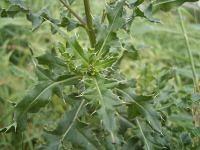
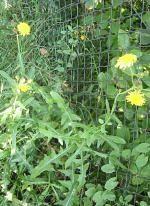
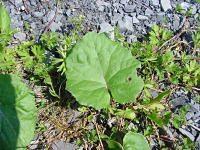
Creeping thistleField milk-thistleColtsfoot
Creeping thistle, field milk-thistle and coltsfoot
In a study into these three weeds, farmers reported the following observations.
Creeping thistle
A certain dynamic character can be perceived in the highly curved shape of the leaf. Its margin features many spines. This means that the vegetative force of the leaf does not extend horizontally, in the plane of the leaf, but shows extreme tension.
Field milk-thistle
The leaf is curved and features many spines along the margins. Its outer margin is lobed; it does not have a simple geometric shape, but is more playful. The leaves protrude from the stalk at an angle. Towards the top of the stalk, they hang down in a free, unconstrained dynamic curve (like an arc of water in a fountain). Like the leaf and its margin, the orientation of the leaves relative to the stalk expresses the playfulness of its abundant vitality as a dynamic quality.
Coltsfoot
Striking features include the long petioles and relatively large, flat leaf blades. The leaf's vegetative force shows a peripheral orientation and is abundantly present there. The same dynamic character is found at the petiole, which is round and fleshy. Its upper surface features a groove with reddish margins. The prickly leaf margin is a surprising feature (Baars and de Vries, 1999).
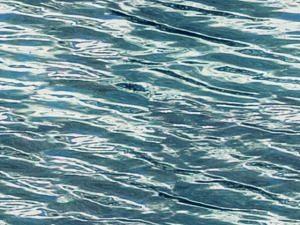
Water: the dynamic element
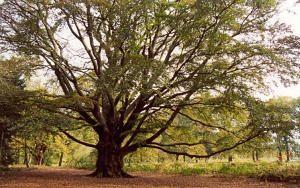
Branches can be seen as a solidified movement

The dynamics of a running horse

Leaves of a strawberry through the year

The colours of the leaves of the strawberry
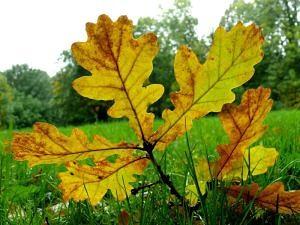
Leaves of an oak
Exercises
You can only do these exercises after you have done the earth-type observations. Try to use expressive imagery in your verbal descriptions. You can also do these exercises in a group and exchange your findings.
Movements of an object
Describe the movement represented by the shape of a solid object. Make an accurate, true-to-life drawing of the movement, using the knowledge you have gained from your earth-type observations. Don't go into details, but use long, flowing lines in your drawing. It might be helpful if you remove the pencil from the paper as little as possible. Clay modelling may be more suitable for animals and other three-dimensional objects. Imitate the movements with your hands and arms or with your whole body. Now try to create a mental image of this movement. Observe your 'dynamic experience' and describe it. Describe your impressions and mood.
Movement in the past
Select a plant, an animal, a farm or something else that has gone through a change or development. Describe the developmental stages of a number of its aspects. Describe the lines of development. Internalise these and describe the experience this provides.
